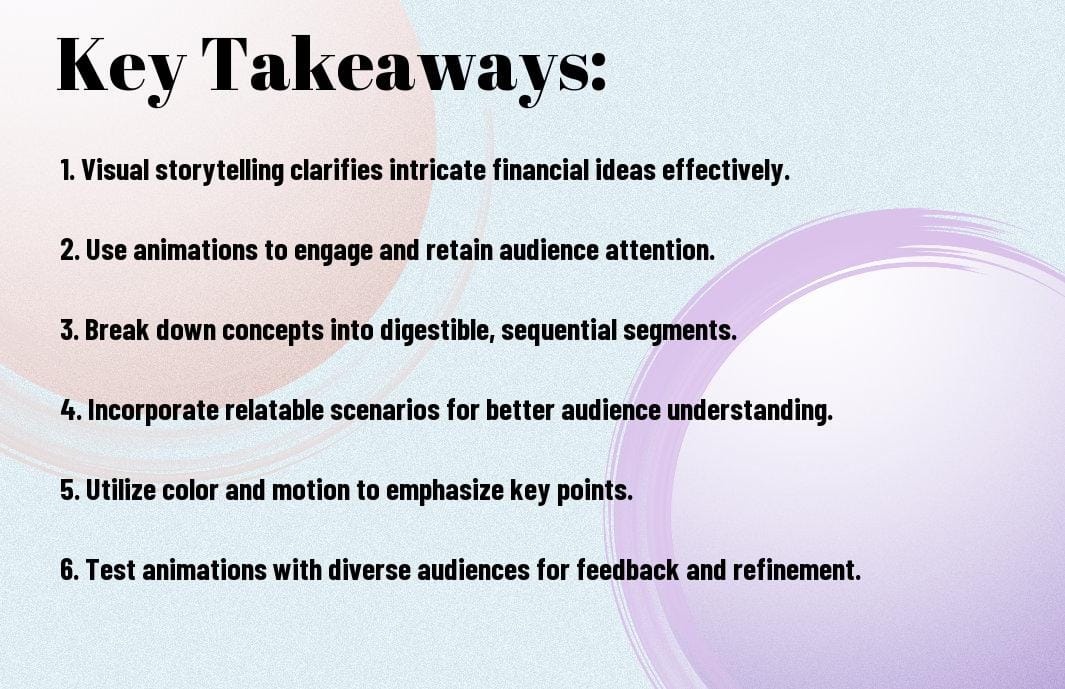With the rapid evolution of financial services, you might find yourself struggling to grasp intricate concepts. Animation serves as a powerful tool to illustrate and clarify these ideas, making them accessible for your audience. By integrating engaging visuals with concise explanations, you can enhance understanding and retention. This blog post will guide you through effective techniques for leveraging animation in financial services presentations, empowering you to simplify complex topics and connect with your audience more profoundly.

Key Takeaways:
- Visual Clarity: Utilize animations to break down intricate financial concepts into simpler, easier-to-digest visuals that enhance understanding.
- Engagement Factor: Incorporate storytelling elements within animations to capture the audience’s attention and maintain interest throughout the explanation.
- Emphasis on Key Points: Use animations to highlight significant data and trends, ensuring that the audience focuses on imperative information without feeling overwhelmed.

Understanding Financial Services
Definition and Scope
Understanding financial services requires a clear grasp of their definition and broad scope. Financial services encompass a range of economic services offered by the finance industry, including banking, investments, insurance, and estate planning. These services are vital for individuals and businesses alike, providing tools for monetary management, risk assessment, and wealth creation. As you navigate through your financial journey, you’ll encounter various instruments and entities that play a significant role in shaping your financial outcomes.
The scope of financial services extends beyond mere transactions to include a comprehensive suite of services designed to enhance your financial literacy. This can include tools for budgeting, financial planning, investment advising, and more. By familiarizing yourself with these services, you empower yourself to make informed financial decisions that align with your life goals.
Importance of Visualization
Importance of visualization in financial services cannot be understated, especially when it comes to making complex concepts more digestible. As you examine into financial planning or investment strategies, you may find the associated data and information overwhelming. This is where visual aids such as graphs, charts, and animations come into play, enabling you to process information quickly and effectively. By translating intricate financial information into visual formats, these tools aid in clarifying patterns, trends, and potential outcomes.
Hence, utilizing advanced visual techniques can significantly heighten your understanding of financial statistics and market dynamics. When you visually engage with your financial data, you can more quickly identify opportunities and risks. Whether you’re assessing investment portfolios or crafting a budget, visualization not only simplifies complex information but also enables you to make more informed decisions, ultimately leading to improved financial health and fulfilling your financial objectives.
The Role of Animation in Financial Education
Some individuals find financial concepts daunting and challenging to grasp. By utilizing animation, you can transform complex information into engaging visuals that facilitate better understanding. Animation serves as a bridge between complicated financial principles and the viewer’s comprehension, making learning more interactive and enjoyable. It allows you to visualize processes, understand relationships, and connect dots in ways static images or text may not achieve.
Benefits of Using Animation
The use of animation in financial education offers several noteworthy advantages. First, it increases engagement, as dynamic visuals naturally catch your eye and keep your attention longer than traditional formats. Furthermore, animations simplify the delivery of intricate information without oversimplifying the content. This means that you can absorb complicated concepts such as investment strategies and financial forecasts with more ease and clarity.
Types of Financial Animations
Behind the versatility of financial animation lies an array of types that cater to various educational needs. Each type can efficiently illustrate different aspects of finance, providing you with tailored solutions for specific challenges. Here’s a look at some of the prominent types of financial animations:
| Type of Animation | Description |
|---|---|
| Explainer Videos | Short videos that break down specific concepts. |
| Infographics | Visuals that combine data and graphics to tell a story. |
| Animated Charts | Dynamic representations of data that change over time. |
| Character-led Stories | Narratives that use characters to explain financial concepts. |
| Interactive Simulations | Engaging experiences that allow you to explore scenarios. |
By understanding the different types of financial animations, you can choose the best format that fits your learning style and educational goals. Each type has its own unique way of communicating information, which can help you retain and apply knowledge effectively.
- Explainer Videos for quick learning
- Infographics for visual learners
- Animated Charts for data analysis
- Character-led Stories for relatable scenarios
- Interactive Simulations to practice in real-time
Benefits of incorporating animation into your financial education strategy are countless and impactful. By capitalizing on the unique advantages of animation, you can enhance your understanding and retention of complex subjects. Below is a summary of some key benefits:
| Benefit | Impact |
|---|---|
| Enhances Engagement | Captures viewers’ attention effectively. |
| Simplifies Complexity | Makes challenging concepts easier to digest. |
| Aids Memory Retention | Improves recall through visual storytelling. |
| Encourages Exploration | Fosters curiosity about financial topics. |
| Provides User Interaction | Engages through participatory learning. |
Utilizing animation within your financial education can yield profound benefits in your learning journey, helping you navigate the complexities of finance with greater ease and confidence. The power of animation can truly revolutionize how you approach financial literacy.
Key Concepts Simplified by Animation
Not only can animation clarify complex financial concepts, but it can also engage viewers in ways traditional formats cannot. When you utilize animation, your audience can grasp themes like financial markets more readily, as these visual narratives can transform abstract ideas into tangible understanding. By presenting dynamic graphs, timelines, and illustrations, you allow viewers to visualize relationships within the financial ecosystem, making it easier for them to comprehend how various market factors influence one another.
Financial Markets
Against the backdrop of ever-evolving economic landscapes, animated explanations can distill a wealth of information regarding financial markets into digestible snippets. You can illustrate how markets operate, shedding light on key roles such as buyers and sellers. Furthermore, you can highlight the interplay between different types of markets—like stocks, bonds, and commodities—helping your audience understand the complexities behind trading mechanisms and market behavior. This engagement fosters not only understanding but also a sense of confidence in your audience’s ability to navigate financial systems.
Investment Strategies
Markets present unpredictable outcomes, yet using animation to depict various investment strategies can help simplify your approach to understanding these risks. When you animate different strategies, such as dollar-cost averaging or diversification, you can effectively illustrate how each serves to mitigate risk while aiming for optimum returns. You allow your audience to visually compare potential outcomes, showcasing the benefits and drawbacks of each strategy within a cohesive framework.
The animated representation of investment strategies transforms dry numbers and theories into entertaining and informative visuals. It can help you pinpoint strategic adjustments based on market conditions, making it easier for you to identify risk management techniques that align with your investment goals. By employing visuals, you enhance engagement and retention of information, allowing you to navigate the intricacies of investing with confidence and clarity.
Designing Effective Financial Animations
For effective financial animations, it’s imperative to follow best practices that resonate with your target audience. Engaging storytelling is fundamental; merging concepts into a narrative helps the viewer build connections and makes the information more relatable. Begin by identifying the key messages you want to convey, and ensure they are presented clearly and simply. Using relatable characters and situations can also enhance engagement, making the financial information feel more approachable and less intimidating.
Best Practices in Animation Design
At the core of effective animation design is the balance between aesthetics and functionality. You should avoid cluttering your animations with excessive information or visuals; instead, focus on one central theme at a time. Keep your visuals simple, using a consistent color palette and typography that aligns with your brand identity. Additionally, pacing is vital. Ensure that your animations progress at a speed that allows viewers to absorb the information without feeling rushed, as this aids comprehension and retention.
Tools and Software to Consider
For creating impactful financial animations, using the right tools and software can greatly enhance the production process. Various platforms like Adobe After Effects and Blender offer advanced features for 2D and 3D animations while being versatile enough to cater to different project needs. If you’re seeking more accessible options, tools such as Animaker and Vyond allow you to create animations through user-friendly interfaces with predefined templates. Additionally, incorporating sound effects and voiceovers can significantly improve the overall quality and engagement level of your animations.
In fact, choosing software that aligns with your skill level is important, as some programs can have a steep learning curve while others are designed for quick and easy access. Assess your unique needs, budget, and resources before making a choice; this way, you can ensure *optimal production efficiency* and *effective outcome*. Engaging with community forums and tutorials can also help you utilize these tools to their fullest potential, making your financial animations not just informative but also visually captivating.

Case Studies: Success Stories
Many organizations have recognized the power of financial services animation in simplifying complex concepts. By employing animation as a tool for communication, these companies have successfully conveyed intricate financial data and strategies to their clients and stakeholders. Here are some notable case studies demonstrating the effectiveness of financial animations:
- Company A: Utilized animated explainer videos, resulting in a 60% increase in customer engagement and a 30% boost in new client acquisitions within six months.
- Company B: Developed an animated infographic for a financial product launch, which led to a 40% increase in conversion rates compared to previous launches without animation.
- Company C: Created a series of animation videos that simplified their annual financial reports. This approach improved audience retention by 50% during presentations.
- Company D: Used animation in employee training programs, enhancing understanding of complex regulations and leading to a 70% reduction in compliance errors.
For more insights into how financial animation can transform your communication strategies, check out Finance Animation Explained | Keystone Media.
Companies Leveraging Animation
After analyzing various successful cases, it’s clear that numerous financial companies have leveraged the power of animation to improve how they deliver information. Whether it’s simplifying intricate financial products or enhancing internal training processes, organizations are tapping into the engaging aspects of animation to convey their messages clearer and more concisely. This approach not only captivates the audience’s attention but also facilitates better understanding, leading to informed decision-making.
Measurable Outcomes
Stories of success with financial services animation reveal significant improvements across various metrics. By integrating animated content, companies have experienced remarkable shifts in their operational performance. These measurable outcomes not only showcase the effectiveness of animation but also provide clear indicators that reinforce the investment in this creative medium.
Animation plays a pivotal role in achieving effective communication. Through these success stories, it becomes evident that utilizing animation leads to greater audience engagement, improved retention rates, and significant conversion rate increases. The numbers speak volumes: companies that invest in animation see a demonstrable return on their investment, proving that this technique is not just a trend but a valuable asset in the world of finance.
Challenges and Considerations
All animations have their unique set of challenges, especially when it comes to conveying financial concepts effectively. One of the primary pitfalls is the risk of oversimplifying the information. While it’s tempting to make financial topics digestible through animation, you must be careful not to strip away vital details that provide depth and context. This can lead to misunderstandings or misinterpretations of the information you want to communicate. Additionally, animations that are too flashy or distracting may divert attention away from the key points, making it harder for viewers to grasp important concepts.
Common Pitfalls
After stepping into animations, you might also encounter the challenge of audience engagement. It’s important to create animations that resonate with your target demographic; otherwise, your efforts may fall flat. If the animation doesn’t align with the interests or knowledge level of your audience, it will likely fail to serve its purpose. Take care in crafting narratives and visuals that will engage viewers emotionally while supporting their quest for financial understanding.
Ensuring Accessibility and Understanding
About ensuring accessibility, it’s vital that your animation caters to a diverse audience. This includes considering those with various learning styles and abilities. Integrating elements such as subtitles or voiceovers can significantly enhance comprehension for individuals with hearing impairments or those who prefer auditory learning. Additionally, using clear language and avoiding financial jargon can help you reach a broader audience, allowing more people to benefit from your animations.
To create effective financial services animations, you’ll need to prioritize accessibility and understanding throughout the entire process. By including clear and concise visual elements alongside verbal explanations, you can help reinforce the message you’re trying to convey. Make it a point to evaluate the final product through the lens of your intended audience; gather feedback, and be willing to make adjustments to enhance clarity. Your objective should be to ensure that everyone, regardless of their background, can engage with and understand your financial concepts without unnecessary barriers.

Final Words
So, as you navigate through the intricate landscape of financial concepts, utilizing financial services animation can serve as a powerful tool in your arsenal. By simplifying complex ideas into engaging visuals, you can enhance your understanding and retention of vital financial information. This approach not only makes learning more enjoyable but also ensures that you can communicate these concepts effectively to your audience. Whether you are explaining investment strategies, budgeting, or the intricacies of loans, animation provides a clarity that traditional methods often lack.
Additionally, incorporating animated content into your financial education strategy allows you to cater to various learning styles. By appealing to visual learners, you can hold their attention and convey your message more effectively. If you want to explore the benefits of this approach further, check out Why Finance Animation is Essential for Your Business. By embracing financial services animation, you empower yourself to tackle complex financial topics with ease and confidence, ultimately leading to informed decision-making in your personal and professional life.
FAQ
Q: What is financial services animation?
A: Financial services animation refers to the use of animated visual content to convey complex financial concepts in an engaging and easily digestible format. This approach utilizes visuals, motion graphics, and storytelling techniques to break down intricate ideas into simpler, more intuitive representations, making it easier for audiences to understand and retain financial information.
Q: How can animation simplify complex financial concepts?
A: Animation can simplify complex financial concepts by utilizing visuals to illustrate abstract ideas. By incorporating colorful graphics, characters, and scenarios, viewers can more easily identify with the content. Animation can also employ metaphors and analogies to relate financial principles to everyday experiences, making the concepts more relatable and easier to grasp.
Q: What types of financial concepts can be effectively illustrated using animation?
A: Various financial concepts can be effectively illustrated using animation, including investment strategies, budgeting techniques, loan processes, retirement planning, and the workings of financial markets. Animations can demonstrate how these concepts operate through step-by-step visuals, helping audiences visualize the processes and understand their implications.
Q: Who can benefit from financial services animations?
A: Numerous audiences can benefit from financial services animations, including individuals seeking personal finance knowledge, students learning about economics, and professionals in the finance sector aiming to simplify their presentations. Additionally, organizations providing financial services can use these animations to educate clients about products and services, improving client engagement and comprehension.
Q: What are some effective ways to distribute financial services animations?
A: Financial services animations can be effectively distributed through various channels, including social media platforms (like YouTube, Facebook, and LinkedIn), websites, and email newsletters. Incorporating animations into webinars and virtual workshops can also enhance the presentation of financial information. Optimizing the animations for mobile viewing ensures accessibility for users on different devices.



